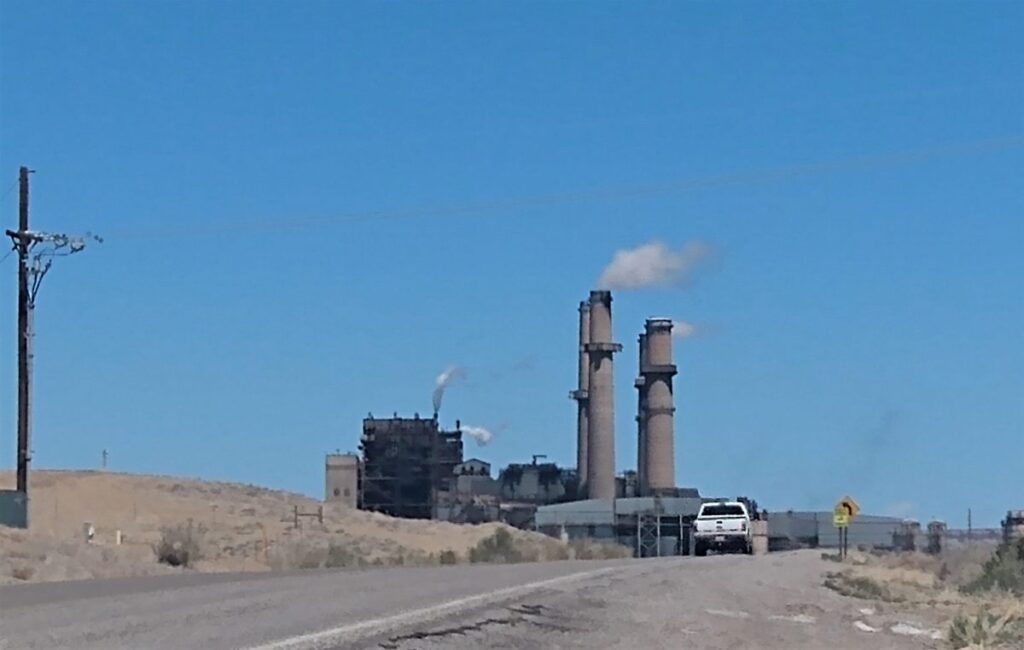PNM asks to continue San Juan Generating Station operations through September

Public Service Company of New Mexico (PNM) plans to continue operations of unit four of the San Juan Generating Station through Sept. 30 to avoid power shortages this summer.
The state’s largest utility announced its plans on Thursday and is seeking approval from the New Mexico Public Regulation Commission.
In an interview with NM Political Report, Vice President of Generation Tom Fallgren said PNM needs the PRC’s approval by March 25 to provide adequate notice to Westmoreland Coal Company, the owner of the San Juan Mine, which provides the power plant with coal. If the extension is not approved, mining at the San Juan Mine will end March 26.
The plant was initially intended to close at the end of June this year; however, supply chain challenges led to a delay in replacement power resources coming online. These resources are expected to be online in September.
Fallgren said in addition to continuing operations of the power plant through September, PNM Resources, the utility’s parent company, has said that PNM’s retail customers will be prioritized for the share of the power produced by San Juan Generating Station that is generally sold on the market.
While PNM will still be slightly short of its ideal reserve margin this summer, Fallgren said the utility will be close to where it has historically been.
PNM has also expressed concerns about resource adequacy for the summer of 2023. Fallgren said that is because PNM will be ending one of its leases at Palo Verde Generating Station, a nuclear power plant located in Arizona, once the lease expires next year. PNM’s other lease at Palo Verde ends in 2024. On Wednesday, the PRC approved replacement resources for the power PNM receives from the Palo Verde plant.
“We appreciate the New Mexico Public Regulation Commission’s finally resolving this case so that PNM can start securing replacement resources before next year’s summer peak. These replacement resources allows PNM to integrate more renewable resources into our grid that provide the best value to PNM customers and support the company’s path to carbon-free electricity,” said Ray Sandoval, a spokesman for PNM, in a statement.
The replacement power case took longer than PNM had anticipated. Generally, the PRC has six months to approve replacement resources. However, that was extended to ten months in the Palo Verde case, which leaves limited time to bring the replacement resources online. These replacement resources are power purchase agreements and energy storage agreements for solar and battery.
Fallgren said extending the life of the San Juan Generating Station into 2023 is not a possibility because it would require developing another panel in the underground mine, which is a labor-intensive process. Westmoreland has already begun layoffs in preparation for the closure of the power plant, which is the mine’s sole customer.
Additionally, the Energy Transition Act includes emissions requirements that would prevent the power plant from operating after Jan. 1, 2023.
Fallgren said PNM cannot continue using 114 megawatts from Palo Verde after its lease ends next year because it was required to give irrevocable notice to the power plant’s owner that it planned to end its use of that resource.
The news of possible power shortages has brought new scrutiny to the PRC and the past abandonment and replacement resources cases. The state Attorney General announced this week an investigation into the PRC’s policies and procedures in light of news that PNM could struggle to meet demand this summer.
During an interview with NM Political Report, Sandoval said the utility isn’t trying to point fingers or engage in “Monday morning quarterbacking.” Instead, he said PNM is looking at what happened to learn from it as the energy transition continues.
The San Juan Generating Station currently has two operating units. Unit one will close at the end of June. Its ownership is split between Tucson Electric Power Company and PNM. Unit Four, on the other hand, is owned by PNM, Los Alamos County, the City of Farmington and Utah Associated Municipal Power Systems.
Fallgren said TEP, which had natural gas and utility-owned assets approved as part of its replacement portfolio, will not need to rely on the coal-fired power plant to meet demands this summer.
If PNM’s original planned resource portfolio, which included utility-owned natural gas, had been approved by the PRC, Fallgren said there would not be a need to continue operations at the San Juan Generating Station after June 30. He explained that the proposed natural gas resources would have relied largely on U.S. manufacturing rather than importing infrastructure like solar panels from overseas.
Camilla Feibelman, director of the Rio Grande Chapter of the Sierra Club, emphasized that the issues leading to the need to extend the life of the San Juan Generating Station are not something that could have been predicted when the PRC approved the replacement power plan.
“At the time that the replacement resources were approved, nobody could have predicted COVID or the related supply chain issues,” she said. “And even if we could have predicted that, there was no way to predict what resources and how that situation might have played out.”
Feibelman further said that the supply chain issues are not limited to just one type of energy source.
Feibelman said the Sierra Club understands PNM’s need to continue the use of the power plant in light of the supply chain issues and the need to provide electricity to customers during peak times this summer.
Mariel Nanasi, executive director of New Energy Economy and one of PNM’s most vocal critics, said she wants to know if the utility did a comprehensive analysis to determine that operating unit four was the most cost effective way to meet the demand this summer. Nanasi said that San Juan was not the only option PNM had, highlighting a presentation PNM Resources’ chairwoman, president and CEO Pat Vincent-Collawn made to investors on Feb. 3. The transcript shows investors asking her about the resource adequacy for the summer and she responded that there would not be rolling blackouts or brownouts because PNM had contingency plans in place.
The transcript quotes Vincent-Collawn as telling investors that there are several options PNM is evaluating to meet power demands and saying “we could keep the plant open a few months longer. We are looking at market purchases. I have [an] 11 by 17 sheet of every option that we are going over and we are close to finalizing that, and we’ll make an announcement on what we’re going to do in the next couple of weeks. But I can assure you we do have the Resources covered for the summer time, but you got it right. It is the west wide problem and actually if you look at what’s going on. Globally, it’s a global problem, But we are fortunate that we’re going to be able to cover.”
Nanasi further criticized PNM and said the utility created the situation. Nanasi said PNM had 345 bids for replacement power projects in January 2018 “and they sat on it for 18 months so that they could get their money under the [Energy Transition Act].”
The Legislature passed that law in 2019.
At the same time, Nanasi acknowledged that nobody could have predicted at that time that the COVID-19 pandemic would occur and lead to the supply chain challenges currently being faced.
PNM is not the only utility facing challenges because of the supply chain. Several rural electric cooperatives have informed the PRC that they are struggling to get things like transformers.
Fallgren said because of PNM’s size and stockpile of things like transformers, it is not facing the same level of challenges on that front that the smaller utilities are and he said PNM may be able to help those smaller utilities by providing them with things like transformers if the need arises.
PNM also announced on Thursday that it will be pre-funding about $8.9 million of the severance and job training money for the coal mine workers as approved by the PRC in the financing case associated with PNM’s application to end operations of the San Juan Generating Station. This money comes from securitization, or refinancing of past investments into the power plant with low-interest bonds, which was made possible by the Energy Transition Act.
In a statement, Vincent-Collawn said it was a priority for PNM to “ensure our northern neighbors impacted by our exit from coal had access to Energy Transition Act funding as quickly as possible.”
This article was originally posted on PNM asks to continue San Juan Generating Station operations through September







